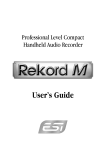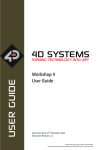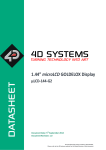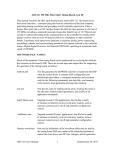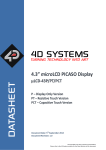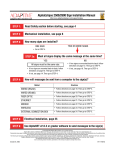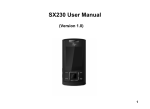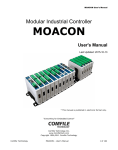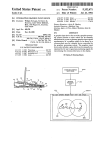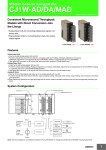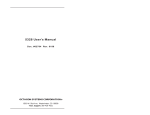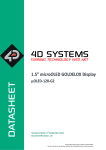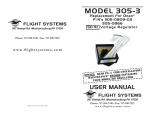Download Modular Development Platform
Transcript
AMEX Research Corporation Technologies Modular Development Platform User’s Guide Modular Development Platform For education of embedded systems and robotics USER'S GUIDE Document Date: 12 August 2013 Document Revision: 1.0 AMEX Research Corporation Technologies www.amex.pl e-mail: [email protected] Page 1 of 55 AMEX Research Corporation Technologies Modular Development Platform User’s Guide Contents 1. Introduction….…………………………………………………………………………………………....................3 2. Features……………………….…………………………………………………………………..……………..............3 3. Hardware Description……………………………….…………….………………………………….……………...5 4. Hardware configuration examples……………….…………………………….……….….………………….7 5. Connectors and Modules on the Modular Development Platform………………………….16 5.1. DC Power Supply…………………………………………………………….………….…………………..16 5.2. Servo Power Supply………………………………………………………..….…………………………..16 5.3. Microcontroller Module…………………………………………………..................................17 5.4. Display Module……….………………………………………………………………………………………17 5.5. The loudspeaker – generating the sounds ………………………………………….......19 5.6. Joystik – 5 position switch……..……………………………………………………………………….20 5.7. Prototyping PC field……………………………………………..…………………………………………20 5.8. Breadboard…………………...……………………………………..………………………………………..20 5.9. Conectors field for external devices………..…………..…………………..……………………..20 5.10. Additional devices for Development Platform……………..………………………………….21 6. Accompanying Modules…………………………………………………………….………………………………35 6.1. 6.2. 6.3. 6.4. Microcontroller Modules………………….………………………………………………………………35 Display Modules.....………………………………………………………………………………………….39 Functional Modules and prototyping boards……………………………………………………44 Click BoardsTM Boards……..……………………………………………………………………………….51 7. Legal Notice……….……………………………………………………………………………….……………………..55 8. Contact data…………………………………………………….…………………………..…………………………...55 AMEX Research Corporation Technologies www.amex.pl e-mail: [email protected] Page 2 of 55 AMEX Research Corporation Technologies Modular Development Platform User’s Guide 1. Description 2. Features The Modular Development Platform by AMEX Research Corporation Technologies is a high quality universal development system intended for education and rapid prototyping of electronic components and devices in the range of embedded systems working with microcontrollers and other accompanying circuitry in professional electronics and robotics. The Modular Development Platform enables to create your own hardware and software environment based on the possibility to choose from a variety of different modules, analog devices and sensors placed by the user on the evaluation board or outside it. The Development Platform equipment: · “Jack” type connector (2,5 mm size with middle positive terminal to connect external 6..9VDC power supply). · On-board two DC regulators (5V DC, max. 1A and 3.3 VDC, max. 0,5A) to power all modules and additional user devices. · 5V and 3.3V connectors to connect to prototyping breadboard and other modules. · Three switches: Power Switch for 5V and 3.3V regulators with LED indicator, display module and servo-mechanisms power (servo can be powered by internal 5V DC from the platform or from external source). · 8Ω loudspeaker with Darlington based amplifier for playing sounds and audio files. · Connectors to install and program 4D Systems displays. · Display reset button. · Additional (10 and 30 pins) connectors to connect user devices with display module. The Modular Development Platform The Modular Development Platform is adapted to install variety of microcontroller modules (including Arduino series) and intelligent graphic displays offered by 4D Systems with miscellaneous resolutions and sizes. The display can work independently without master microcontroller. All display modules include memory for storing graphic files, animations and audio and video files. · 5 position Joystick. · 10-terminal connector for configuring serial interface, audio circuitry and joystick. · Connectors for external devices and 4 servomechanisms. · Field for installing different microcontroller modules (e.g. Arduino, Cubloc, Basic Stamp, Basic Micro, Amex and others) and also accompanying modules by Mikroelektronika, Sparkfun, Parallax, Pololu. · I2C interface voltage translator. · Field for installing other modules. · Field for installation of prototype board (for example: mikro BUS Shield, PROTO Shield etc.). Graphic display and other modules mounted in the Development Platform Additional modules and devices are purchased independently or made by users in the form of prototype PCBs and installed on the development platform. AMEX Research Corporation Technologies · 4 RGB LEDs (controlled by user devices). · 4 illuminated buttons with two-color LEDs and controller. · Solder-less breadboard (400 or 800 contacts) for quick prototyping. · Size: 220mm x 160 mm x 13mm www.amex.pl e-mail: [email protected] Page 3 of 55 AMEX Research Corporation Technologies Modular Development Platform User’s Guide An example of configuration of the Modular Development Platform AMEX Research Corporation Technologies www.amex.pl e-mail: [email protected] Page 4 of 55 AMEX Research Corporation Technologies Modular Development Platform User’s Guide The Modular Development Platform for education of embedded systems and robotics 3. Hardware Description The Modular Development/Evaluation Platform by AMEX Research Corporation Technologies is a high quality universal development board intended for practical education in the range of application of modern electronic devices and circuits working with microcontrollers. Such solutions are often called embedded systems. They require quite new approach in the preparation of educational theory and conducting practical exercises (laboratories, workshops) and also creating own solutions by students, designers, engineers and hobbyists with different interests and specializations. The Modular Development/Evaluation Platform is an ideal tool for education and rapid creating of prototypes. Fig. 1. The Modular Development Platform with exemplary modules It allows a relatively quick and effective learning practical aspects of professional electronic circuits for the needs of automatics, sensor systems, telecommunication, information technology, mechatronics and robotics. The Modular Development Platform is also a very interesting, valuable and far incentive tool which can be used for independent learning professional electronic circuits. The board can be successfully used by beginners. A characteristic feature of the Development Platform is the possibility of creating your own hardware and software environment based on the possibility to choose from a variety of modules placed by the user on the main board or outside it. The modules are manufactured by different producers which gives the user a freedom in optimal choice of devices and components that help him to design AMEX Research Corporation Technologies www.amex.pl e-mail: [email protected] Page 5 of 55 AMEX Research Corporation Technologies Modular Development Platform User’s Guide his final application. The user can also connect his own modules mounted on prototype PCBs. A very important and noteworthy feature of the Development Platform is the possibility to use many different microcontrollers and programming languages. Depending on the user’s preferences, preparation degree, complexity of the design and financial aspects he can choose the type of the microcontroller based for example, on a very popular Arduino family (including the original versions and compatible ones). Other microcontroller modules can be chosen as well (such as Basic Micro, Comfile Technology Inc., Olimex, Parallax Inc.). An exemplary configuration of the Development Platform/Board is shown in Fig. 1. A relatively quickly gaining of basic skills of using hardware and software is a highly motivating factor for persons who are interested in these fields. They will certainly improve their skills with enthusiasm in the range of practical application of microprocessor technology with the use of the Development Platform. The fundamental element of the Modular Development Platform is a main board of size 220 mm x 160 mm. It is designed in a way allowing of connecting all accompanying modules by the means of connectors, solder-less breadboard, cables, wires etc. The user chooses modules that will be placed on the board. Only the modules and components selected by the user work with the main board. There is no need to place the whole range of other devices and components (that are not needed in the project) which is typical solution used by other producers. Such an idea makes the design more flexible and easier to use during designing. If needed, the user can decide himself if he wants to expand capabilities of the hardware of his design with the use of modules and components from other producers. Fig. 2 The Modular Development Platform (the main board) AMEX Research Corporation Technologies www.amex.pl e-mail: [email protected] Page 6 of 55 AMEX Research Corporation Technologies Modular Development Platform User’s Guide The breadboard (a white contacts unit) can be increased by an identical one (400 contacts) situated (if needed) in the place that is normally reserved for other module (Fig. 3). The knowledge of the development platform boils down to usage and knowledge of used modules and their proper placement on the platform. Fig. 3 The main board with additional solder-less breadboard (2 x 400 contacts) The board is equipped with a DC regulator (5V and 3.3V). It is also possible to use DC regulator built into microcontroller module (for example Arduino, Comfile Techn., Parallax, Basic Micro). An example of placement of a variety of modules is shown in Fig. 22-25 (DC regulator, microcontroller module, color graphic display and others). 4. Hardware configuration examples A very valuable feature of the Development Platform is the possibility of installation of the 4D Systems intelligent color graphic display which can work independently without the control of external microcontroller. You can choose different sizes and resolutions including 96x64, 128x128, 160x128, 320x240, 400x240 (pixels). The displays contain memory for storing graphic files and also video and audio files (µSD connector included). AMEX Research Corporation Technologies www.amex.pl e-mail: [email protected] Page 7 of 55 AMEX Research Corporation Technologies Modular Development Platform User’s Guide The 4D Systems displays family dedicated for the Development Platform is an efficient and friendly development platform for the application of graphic interface in many devices created by the user. Depending on the particular type of the display it is possible to choose one with larger resolution with touch panel (for 320x240 and 400x240 resolutions). Such a solution paves the way to resignation of using conventional user interfaces based on mechanical components like keypads, buttons, switches, knobs etc. It makes the construction of device enclosure easier and improves comfort for the user. An important feature of all graphic displays used in the Development Platform system is the ability to select two modes: external control mode with master microcontroller communicating through serial interface (UART) or stand-alone mode. The mode choice is made with the use of a file provided by 4D Systems. When display is configured in serial interface mode it utilizes simple programming language called 4DGL (4D Graphics Language) to control graphic functions. The 4DGL is similar to C or C++ language and is user-friendly language and easy to learn. It can be successfully used for all graphic displays indented for the Development Platform. All graphic displays used in the Development Platform have a feature of universality and cross-compatibility. The change of display does not expose the user to time-consuming and costly changes in software. Once written software can be easily adapted to other types of displays. For more info about the 4DSystems display Modules please see: www.4dsystems.com.au The use of such types of displays virtually eliminates the risk of failure when designing graphic user interface even by less experienced designers. The 4D Systems company also offers free 4D-Workshops IDE software and powerful graphic editor 4D-ViSi intended for simple and intuitive manipulating of graphic visual components used for control and visualization in measurement and control processes in automatics and robotics. Among others these include such components like buttons, measuring instruments, sliders, switches etc. It enables to eliminate the need of frequent changing the code in the display during designing stage. AMEX Research Corporation Technologies www.amex.pl e-mail: [email protected] Page 8 of 55 AMEX Research Corporation Technologies Modular Development Platform User’s Guide It is worth noting that these graphic displays are excellently suited for creating modern equipment intended for education purposes in conducting practical exercises in technical universities and schools. The aim of the exercises is to learn construction and technology of specialized devices, embedded systems, intelligent sensors and communication interfaces in automatics, measurements and robotics. The offered Modular Development Platform utilizing advanced graphic displays enables to combine theory and practice for the needs of designing, prototyping, modernization, maintenance and service of electronic equipment which contains microcontrollers and modern and specialized electronic circuits including embedded systems equipped with software designed to realize functions intended for the given device. AMEX Research Corporation Technologies www.amex.pl e-mail: [email protected] Page 9 of 55 AMEX Research Corporation Technologies Modular Development Platform User’s Guide Fig. 4. Modular Development Platform with microcontroller module, LCD display and data acquisition module with I2C interface Fig. 5. An exemplary configuration of the platform with a variety of modules AMEX Research Corporation Technologies www.amex.pl e-mail: [email protected] Page 10 of 55 AMEX Research Corporation Technologies Modular Development Platform User’s Guide Fig. 6. An exemplary configuration of the platform with a variety of modules Fig. 7. An exemplary configuration of the platform with a variety of modules AMEX Research Corporation Technologies www.amex.pl e-mail: [email protected] Page 11 of 55 AMEX Research Corporation Technologies Modular Development Platform User’s Guide Fig. 8. An exemplary configuration of the platform with a variety of modules Fig. 9. Connectors placements for external units AMEX Research Corporation Technologies www.amex.pl e-mail: [email protected] Page 12 of 55 AMEX Research Corporation Technologies Modular Development Platform User’s Guide Fig. 10. Example of connection of other external devices/modules: 8-LED module, encoder, joystick, keypad and 8 potentiometers Fig. 11. Example of connection of other external devices. View of prototyping PCB with two joysticks and RGB LED driver AMEX Research Corporation Technologies www.amex.pl e-mail: [email protected] Page 13 of 55 AMEX Research Corporation Technologies Modular Development Platform User’s Guide Fig. 12. Connection of two external modules (2 x 8 LED) do J10 and J13 connectors on the breadboard. The breadboard was increased by additional unit (800 contacts) with two joysticks and other modules The Modular Development Platform is an ideal solution for many small companies which plan to design and manufacture their own devices based on more advanced microporcessor technology. Time-to-market will be considerably decreased thanks to using efficient hardware and software tools. It gives the opportunity of fast gaining practical skills connected with designing and fast introduction your products to the market. It gives the ability to quickly acquire practical skills in the design process and rapid implementation of products without the need of long period of learning and substantial costs of possible cooperation with other companies. AMEX Research Corporation Technologies www.amex.pl e-mail: [email protected] Page 14 of 55 AMEX Research CorporationFig. Technologies Modular Development Platform User’s Guide 13. Placement of modules and connectors Power switch Display Reset Display switch Jack (6 - 9 VDC) Other modules DC regulator (for example I2C Flexel) Display Microcontroller Module Joystick 4 x LED RGB Four illuminated buttons (with bicolor LEDs) GND 5V 3.3V Prototype board DC Power Connectors for external devices and servos Servo switch connectors Display programming connectors I2C translator (for example: mikro BUS Shield) Breadboard (contscts AMEX Research Corporation Technologies www.amex.pl e-mail: [email protected] Page 15 of 55 AMEX Research Corporation Technologies Modular Development Platform User’s Guide 5. Connectors and modules on the Modular Development Platform Fig. 13 shows the placement of modules and connectors on the Development Platform. Schematics is shown in Fig. 19 - 21. 5.1. DC power supply (Fig. 13, 15, 19) The Development Platform contains DC power regulator providing two stabilized voltages: +5V and +3.3V. The regulator is powered from external source through J1 jack connector (it must be in the range of 6..9V, 1A). DC regulator schematics is shown in Fig. 19. The stabilized voltages 5V (max. 1A at 6V input voltage) and 3.3V (max. 0.5A). Overall current consumption can not exceed 1A. In order to simplify power distribution on the board (or outside it) to other modules, terminals in J3, J4 and J5 connectors are shorted (see the J3, J4 and J5 in Fig. 15 and 21). Power supply is turned on with SW1 switch. The display power supply voltage is turned on with SW2 switch (when SW1 is closed). Most of microcontroller modules (ARDUINO series for instance) have built-in DC regulator (5V and 3.3V) powered from external voltage source (6-9V). Therefore, it is possible to use one of the regulators connected to external source (provided through JACK connector on the board). In this case one has to connect J2 connector with Vin terminal of microcontroller module and ground (GND) using two separate wires. NOTE 1: It is advised to use 5V and 3.3V outputs from DC regulator on the board as their power is higher than ones available in microcontroller modules. In no case one can connect 5V and 3.3V outputs with the same voltage outputs in microcontroller module. You must observe correct polarity of extetrnal power supply connected to JACK connector (placed on the board or microcontroller module). In all cases J3, J4 and J5 connectors can be used to distribute power supply voltage to the breadboard and other units on the board. 5.2. Servo power supply (Fig. 16, 20) In case when larger power consumption is required, J9 connector is intended to provide external power supply for servos (VS). One must also observe correct polarity (it is printed at J9 connector with “+” and “GND” symbols). The power for servos is turned on with SW4 switch. It is convenient way to switch off the power in case of testing circuits where unpredictable behavior of servos can occur. The choice of power type (5V internal or external) can be made by proper setting a jumper in J17 connector. External power supply is used when the jumper in J17 connector is set to “VS” position. To select internal +5V supply (placed on the board) J17 jumper must be set in “5V” position. NOTE 2 In case of using a microcontroller module working with Parallax BES you must disconnect J3, J4, and J5 connectors from breadboard and not to use external power supply for servos (+5V, 3.3V; 1A) because Parallax BES already includes 5V and 3.3V DC regulators. It is described in Parallax BES user manual (www.parallax.com) where you can see BES board with Arduino module (or compatible one) placed underneath it. The module is fixed to the board with 3mm (diameter) screews and spacer sleeves (15-20 mm long). The screws have to be placed in proper holes adapted to a given microcontroller module. The module is fixed in the field described as “Microcontroller Module”. AMEX Research Corporation Technologies www.amex.pl e-mail: [email protected] Page 16 of 55 AMEX Research Corporation Technologies Modular Development Platform User’s Guide You will also find othetr holes prepared to mount other units such as „ARDUINO module” (and compatible), „PROTON module”, ARC32 (Basic Micro) and Parallax BES. 5.3. Microcontroller Module (Fig. 13, 22-25) The microcontroller module is mounted on the Development Platform with 3mm screws and spacing sleeves (15-20 mm) in the holes adapted to particular module type. Fig. 13 shows microcontroller module which is described on the board as „Microcontroller module”. The Development Platform have appriopriate fields with holes for screws adapted to particular microcontroller modules (for example „ARDUINO module” and compatible, „PROTON module”, ARC32 (Basic Micro) and Parallax BES. The examples of microcontroller modules are shown in Fig. 22-25. 5.4. Display Modules (Fig. 13, 14) The field marked as ”Display” is prepared to install one of many types of color graphic displays (OLED or LCD technology) by 4D Systems. A datailed description and instructions connected with the displays and programming can be found at producer’s website: www.4dsystems.com.au. Examples of various types of displays installed on the board µOLED-160-G2 µLCD-144-G2 µLCD-24PTU µLCD-32WPTU Moduły wyświetlaczy podłączane są do nastę AMEX Research Corporation Technologies www.amex.pl e-mail: [email protected] Page 17 of 55 AMEX Research Corporation Technologies Display Type µOLED-128-G2, µOLED-160-G2 µOLED-96-G2, µLCD-144-G2 µLCD-24/28/32/32WPTU Modular Development Platform User’s Guide Connector on the platform J22 J23 J19, J21 The placement of connector for different displays is shown below. The schematics is shown in Fig. 14, 18 and 21. Display switch and reset button µLCD-24/28/32/32WPTU J22 J24 µOLED-128-G2 µOLED-160-G2 J19 J20 J23 µOLED-96-G2 µLCD-144-G2 J21 Loudspeaker Joystik J6 J7 Fig. 14. Placement of connectors for different types of displays The µOLED-12-G2 i µOLED-160-G2 displays The signals connected to displays terminals are also routed to 10-pin J6 connector situated on top side of the breadboard. NOTE: The display terminal No. 10 provides 3.3V power supply not from display itself but from 3.3V regulator on the board which can deliver higher power. To program the display you must connect programming cable (4D Programming Cable) to lower part of J6 connector (terminals 1, 3, 5, 7, 9) or connect the cable to J7 connector (at the right side of J6 connector) which is intended for programming all types of 4D Systems displays used on the Development Platform. AMEX Research Corporation Technologies www.amex.pl e-mail: [email protected] Page 18 of 55 AMEX Research Corporation Technologies Modular Development Platform User’s Guide During the display programming (by means of 4D Programming Cable) the power supply is drawn from USB interface. The change of power supply source is done automatically (from DC regulator on the board to one delivered by USB cable). There is no need to use SW1 switch. SW1 switch does disconnect +5V voltage from USB interface. Only disconnection of the cable from J7 connector will turn off the power supply drawn from USB. NOTE: Improper connection of programming cable (due to reversal plugging or displacement of terminals) will damage the display. The main power supply for the board should be switched off during installation of the display. Detailed instruction concerning the displays programming can be found in their datasheets at 4D Systems website www.4dsystems.com.au. The µLCD-24PTU, µLCD-28PTU, µLCD-32PTU, µLCD32WPTU displays The µLCD-24/28/32/32WPTU display module are installed in vertical direction on 10 and 30 terminal female connectors J19 and J21 on the platform. The signals available in display connector are routed to J6 male connector placed at upper part of the breadboard and also to 30 terminal J20 connector. NOTE: terminal No. 10 in J6 provides 3.3V power not from display module but from 3.3V regulator on the board which can provide higher power, During the display programming (by means of 4D Programming Cable) the power supply is drawn from USB interface. The change of power supply source is done automatically (from DC regulator on the board to one delivered by USB cable). There is no need to use SW1 switch. SW1 switch does disconnect +5V voltage from USB interface. Only disconnection of the cable from J7 connector will turn off the power supply drawn from USB. NOTE: Improper connection of programming cable (due to reversal plugging or displacement of terminals) will damage the display. The main power supply for the board should be switched off during installation of the display. Detailed instruction concerning the displays programming can be found in their datasheets at 4D Systems website www.4dsystems.com.au. 5.5. The loudspeaker – generating the sounds (Fig. 13, 18, 21) The µOLED-96/128/160-G2 and µLCD-144-G2, µLCD-24/28/32/32WPTU displays have the ability to generate advanced sounds and music. The audio signals for these purposes are available at additional terminals in display connector. To connect audio signal to speaker circuit you must use a jumper in J24 connector to select AUD pin. More information is available in chapter 5.10. AMEX Research Corporation Technologies www.amex.pl e-mail: [email protected] Page 19 of 55 AMEX Research Corporation Technologies Modular Development Platform User’s Guide 5.6. Joystik – 5 position switch (Fig. 18, 21) A joystick is a 5-position switch. Each position will connect different resistor in a resistive voltage divider (Fig. 18 and 21 schematics). The GOLDELOX displays have built-in A/D converters which measure voltage from the resistive divider. The IO1 signal in µOLED-96/128/160-G2 and µLCD-144G2 displays can be configured in analog mode to measure the voltage from the divider. Each position of the joystick will produce different voltage that after measuring will be converted into information about joystick position (more information in chapter 5.10). 5.7. Prototype Board field (Fig. 13) This field is prepared to install any prototype devices mounted on PROTO Shield, BUS Shield boards etc. If mounting holes do not match those on the Development Platform the user must drill new ones in prototype boards. 5.8. Breadboard (contacts board) (Fig. 13) The Evaluation Board contains a breadboard (a special board with a large number of contacts) with the ability to install another one. Single breadboard includes 400 contacts (see Fig. 1-13). The choice of breadboards quantity depends on the contacts number requirement the user needs to install his components and devices. The second breadboard can be mechanically connected with the first one with the use of special outlets available on shorter edges of the breadbord. The additional board can be removed at any time by disconnecting the outlets. When two breadboards are used the field intended for installation of an additional prototype PCB is not available. Thus, the prototype PCB (mikro BUS Shield for example) has to be placed outside the Development Platform. 5.9. Connectors for servos and external devices/modules (Fig. 13, 16, 20) Servos can be connected to J15 and J16 connectors (4 servos max.). Control signals must be connected with wires to J18. J18 terminals are connected with appriopriate ones in J15 and J16. The SW4 switch is used to turn on/turn off servos power supply. The choice of servos power supply source is made by using a jumper in J17 (+5V from regulator on the board or external power from power supply connected to J9 (VS) ). The maximum voltage value can not exceed +6V. The male connectors J10 and J13 are intented for connection of any external modules with extension cable. Alternatively, the external modules can be installed directly on J10 and J13 (see examples shown in Fig. 10, 12 and 24). The female matching connectors J11 and J14 are used to connect signals and power supply from the breadboard or directly from microcontroller module. J12 connector (related to J13 and J14) is intended to connect other modules working with SPI and I2C interface. NOTE: In order to avoid errors when using connectors for external devices it is needed to know the placement of all the signals available (see the schematics in Fig. 20 and 21). AMEX Research Corporation Technologies www.amex.pl e-mail: [email protected] Page 20 of 55 AMEX Research Corporation Technologies Modular Development Platform User’s Guide 5.10. Additional devices (Fig. 17, 20, 21) The Modular Development Platform is equipped with three extra devices including I2C voltage translator, RGB LED diodes and 4 illuminated buttons (Fig. 17, 20, 21). They can be used in many designs. There is also a connection selector (Fig. 18, 21). I2C Voltage translator (Fig. 17, 21) The I2C voltage stranslator is a chip that allows to connect circuits with I2C interface powered from sources with different voltages. I2C interface is used as a communication channel between different circuits within a single appliance or single PCB. The designer can come across a problem with different voltages powering a microcontroller and periheral devices. For example, A/D converters are powered from 5V in order to achieve good performance but the master microcontroller is powered from 3.3V (on the Development Platform 5.0V is used to power 4D Systems displays). In such case it is necessary to employ so called voltage translator for SDA and SCL signals (in J25 male connector) between microcontroller and external device. The signals at microcontroller side (side A) are marked as SDAA (terminal 15) and SCLA (terminal 17). In turn, signals at external device (side B) are marked as SDAB (terminal 16) and SCLB (terminal 18). The voltage supply for both sides (A and B) is marked as VCCA and VCCB (5V or 3.3V depending on jumpers setting). The I2C translator is based on PCA9517 chip. The levels of voltages at A and B sides are set by the use of jumpers. To select given voltage for each side the jumpers in J25 connector must be set as follows: Side A 5V: terminals 3 and 1 shorted Side B 5V: terminals 4 and 2 shorted 3,3V: terminals 3 and 5 shorted 3,3V: terminals 4 and 6 shorted NOTE: Any combination of power supply voltages can be used at both sides A and B Fig. 17 shows examples of connections. For A side the power supply voltage is set to 3.3V (terminals 3 and 5 shorted). For B side, the voltage is set to 5V (pins 2 and 4 shorted). Please pay attention to correct setting of the jumpers. NOTE: All devices working with the translator must also include pull-up resistors connected to chosen voltages at both sides of SCL and SDA signals. At the A side resistors with fixed value 10 kΩ are used (R11 and R12). At the B size the resistors (R13 and R14, 10 kΩ each) may be disconnected by removing appriopriate jumpers (9 and 11 terminals for R13 and 10 and 12 terminals for R14). If the device working at B side contain its own pull-up resistors the R13 and R14 resiistors can be used or not. Decision on whether the resistors are used or not is up to external resistors value because their resultant resistance will be lower (parallel resistors). Fig. 17 shows an example of setting the jumpers for used R13 and R14 resistors (terminals 9 and 10 are shorted to select R13 resistor; terminals 10 and 12 are shorted to select R14 resistor). AMEX Research Corporation Technologies www.amex.pl e-mail: [email protected] Page 21 of 55 AMEX Research Corporation Technologies Modular Development Platform User’s Guide NOTE: Besides voltage translation the PCA9517 also allows to connect larger number of devices at both sides A and B (it has also a function of a buffer). The total capacitive load (for each side) can be up to 400 pF. It allows to place much larger connections for external devices. J12 connector is intended to connect external devices. Transmission signals can be connected to J13 and J14 (Fig. 16 and 20). More information about PCA9517 chip can be found at (www.ti.com or www.nxp.com). RGB LEDs (Fig. 17) There are four RGB LED diodes placed at the left side of the Development Platform which can be controlled by user’s circuit. The diodes are powered from 5V through 1.2 kΩ resistors and enabled by shorting appriopriate terminals in J8 connector. Each diode (DM1, DM2, DM3, DM4) contains three separate diodes: red, green and blue. There are 12 diodes in total. Such solution allows to use simple driving circuit for 12 diodes in order to achieve any combination of colors and light effects. To turn on the diodes, their terminals have to be shorted to ground (GND) using 1-12 terminals in J25. The diodes can also be driven by logic or microcontroller output ports (with output current rating no lower than 2 mA) or by a switch, transistor or relay contacts. Illuminated buttons There are four illuminated buttons at the left side of the Development Platform. The backlight is produced by two-color LED (red and green) driven by two 74HC04 chips (inverters). The color of the two-color LED depends on voltage polarity applied to it. The polarity change is made by two inverters driving each diode through 1 kΩ. When two identical logic levels are present at the diode (both ”0” levels at each input of two inverters or both ”1” levels) it will be turned off. In turn, when there are different levels at each inverter input the diode will be turned on. The diode lights when ”1” and ”0” levels are applied (green color). The ”0” and ”1” combination will result in red color. The logic levels are fed into inverter inputs (J26 male connector). The numbers of illuminated buttons and terminals for two color LED in J26 connector (Fig. 17) Diode/button number 1 2 3 4 terminal numbers of inputs to drive two color diode in the button 1, 2 1, 2 3, 4 3, 4 5, 6 5, 6 7, 8 7, 8 NOTE: Applying logic „1” (=5V) at terminal marked with green or red color will result in lighting the diode with the color shown in the table above. Identical logic levels applied at these terminals will cause the diode to turn-off (for example 5, 6 or 5,6 or 5,6). If there are not any logic levels at 1-8 terminals it is assumed that ”0” level is present. The numbers of terminals written in black color in the table stand for ”0” logic level (=0V). AMEX Research Corporation Technologies www.amex.pl e-mail: [email protected] Page 22 of 55 AMEX Research Corporation Technologies Button number 1 2 3 4 Modular Development Platform User’s Guide Number of output terminal 12 14 11 13 The Connection Selector (J24) (Fig. 14, 18, 21) J24 connector is intended to configure audio, joystick and serial interface between display and teh evaluation board. TX RX AUD AUD JOY 2 10 1 9 The chosen configuration is active when appriopriate connector terminals are shorted with a jumper The jumber must be placed in vertical direction as follows: (1, 2), (3, 4), (5, 6), (7, 8), (9, 10). · · · · · TX – terminals (1,2) shorted, TX from the display connected to a given connector on the board RX – terminals (3,4) shorted, RX from the display connected to a given connector on the board AUD – terminals (5, 6) connect IO2 display port with audio circuit on the board. It concerns all the displays modules with GOLDELOX controller. AUD – other combination of jumpers (7,9) connect AUDIO_IO port of µLCD24/28/32/32WPTU with audio circuit on the board. AUDIO_IO is a terminal that generates audio signal from the display. If AUDENB in the display is active (audio device is on) the sound will also be generated by the audio circuit on the board. It is advised to turn off AUDENB function in the display module if the audio circuit on the board is in use. JOY – when (9, 10) terminals are shorted the joystick is connected with IO1 signal of display module. This connects all the IO1 terminals of all displays modules but it is only compatible with displays equipped with GOLDELOX processor because PICASO processor does not have A2D terminal. When µLCD-24/28/32/32WPTU are used the jumper should be removed. AMEX Research Corporation Technologies www.amex.pl e-mail: [email protected] Page 23 of 55 AMEX Research Corporation Technologies Modular Development Platform User’s Guide SW2 SW3 SW1 J1 J2 J3 J4 J5 J1 SW1 J2 SW2 SW3 J3 J4 J5 Fig. 15. Power supply circuit and its placement on the Evaluation Board AMEX Research Corporation Technologies www.amex.pl e-mail: [email protected] Page 24 of 55 AMEX Research Corporation Technologies J10 J11 J13 J14 Modular Development Platform User’s Guide J9 J12 SW4 J15 J16 J18 J17 J10 J11 J13 J14 J9 J12 J18 J17 J15 SW4 J16 Fig. 16. Schematics of connectors for external devices and servos AMEX Research Corporation Technologies www.amex.pl e-mail: [email protected] Page 25 of 55 AMEX Research Corporation Technologies Modular Development Platform User’s Guide I2C interface buffer J25 J25 J8 RGB LEDS x 4 J8 4 4 illuminated buttons 3 1 2 3 4 J26 2 1 J26 BUTTONS Fig. 17. Schematics of I2C interface connection, RGB LEDs and illuminated buttons AMEX Research Corporation Technologies www.amex.pl e-mail: [email protected] Page 26 of 55 AMEX Research Corporation Technologies Modular Development Platform User’s Guide J22 J24 J19 J20 J23 J21 J6 J7 J20 J22 J23 J24 J7 JOYSTICK J19 J6 J21 Fig. 18. Displays connectors, audio and joystick AMEX Research Corporation Technologies www.amex.pl e-mail: [email protected] Page 27 of 55 AMEX Research Corporation Technologies Fig. 19. Power supply Modular Development Platform User’s Guide 5V DC EGULATOR POWER SUPPLY SOURCE SWITCH POWER INDICATOR AMEX Research Corporation Technologies 3,3V REGULATOR DISPLAY RESET www.amex.pl e-mail: [email protected] Page 28 of 55 AMEX Research Corporation Technologies Modular Development Fig. 20. Connectors for external devices, illuminated buttons andPlatform servosUser’s Guide ILLUMINATED BUTTONS LEDs CONNECTORS FOR EXTERNAL DEVICES SERVOS POWER SUPPLY I2C/SPI SERVOS CONNECTORS ILLUMINATED BUTTONS AND LEDs CONNECTOR AMEX Research Corporation Technologies www.amex.pl e-mail: [email protected] Page 29 of 55 AMEXFig. Research Corporation Technologies Modular Development User’s Guide 21. Connectors of power supply, display, joystick, RGB LEDs and Platform I2C translator PICASO DISPLAY MALE CONNECTOR 128 & 160 DISPLAY HEADER AUDIO SELECTION JUMPER 96 & 144 DISPLAY HEADER RGB DIODES CONNECTOR PICASO DISPLAY FEMALE HEADERS 4 X LED RGB JOYSTIK I2C TRANSLATOR DISPLAY PROGRAMMING CONNECTOR POWER SUPPLY CONNECTORS AMEX Research Corporation Technologies www.amex.pl e-mail: [email protected] Page 30 of 55 AMEX Research Corporation Technologiesof modules on the Development Modular Development Platform User’s Guide Fig. 22. Placement Platform AMEX Research Corporation Technologies www.amex.pl e-mail: [email protected] Page 31 of 55 AMEX Research Corporation Technologiesof modules on the Development Modular Development Platform User’s Guide Fig. 23. Placement Platform AMEX Research Corporation Technologies www.amex.pl e-mail: [email protected] Page 32 of 55 AMEX Research Corporation Technologies Modular Development Platform User’s Guide Fig. 24. Placement of modules and connectors on the Development Platform AMEX Research Corporation Technologies www.amex.pl e-mail: [email protected] Page 33 of 55 AMEX Research Technologies Modular Development Platform User’s Guide Fig. 25.Corporation Placement of modules and connectors on the Development Platform AMEX Research Corporation Technologies www.amex.pl e-mail: [email protected] Page 34 of 55 AMEX Research Corporation Technologies Modular Development Platform User’s Guide 6. Accompanying Modules This chapters describes additional accompanying modules which can be used by the user with the Development Platform. NOTE All devices presented in this User’s Manual can be purchased in AMEX Research Corporation Technologies company. Website: www.amex.pl, e-mail: [email protected] 6.1. Microcontrollers modules Producers: Arduino, Basic Micro, Parallax, Olimex, Comfile Technology Inc., Amex ARDUINO ARC32 (Basic Micro) AMEX Research Corporation Technologies www.amex.pl e-mail: [email protected] Page 35 of 55 AMEX Research Corporation Technologies Modular Development Platform User’s Guide Mad Hatter module (Basic Micro) + PARALLAX BEC (Parallax) = PARALLAX BEC (a Basic Micro microcontroller module is placed underneath) AMEX Research Corporation Technologies www.amex.pl e-mail: [email protected] Page 36 of 55 AMEX Research Corporation Technologies Modular Development Platform User’s Guide OLIMEXINO-32U4 ( Olimex) OLIMEX-STM32U4 (Olimex) AMEX Research Corporation Technologies www.amex.pl e-mail: [email protected] Page 37 of 55 AMEX Research Corporation Technologies Modular Development Platform User’s Guide CUBLOC 210 (Comfile) StampDuino (Parallax) Basic Stamp module (Parallax) + PROTON (AMEX Research Corp. Techn.) AMEX Research Corporation Technologies www.amex.pl e-mail: [email protected] Page 38 of 55 AMEX Research Corporation Technologies Modular Development Platform User’s Guide 6.2. Displays modules Producer: 4D SYSTEMS More information at: www.4dsystems.au Type: µOLED-96-G2 (SGC/GFX), resolution: 96x64, screen size: 0,96” µOLED-128-G2 (SGC/GFX), resolution: 128x128, screen size: 1,5” Type: µOLED-160-G2, resolution: 160x128, screen size: 1,7” Type: µLCD-144-G2, resolution: 128x128, screen size: 1,44” AMEX Research Corporation Technologies www.amex.pl e-mail: [email protected] Page 39 of 55 AMEX Research Corporation Technologies Modular Development Platform User’s Guide Type: µLCD-43PT (SGC/GFX), resolution: 480x272 QVGA, screen size: 4,3” Touch panel Type: CB-128-G1 Carrier Board (for µOLED-128-G1(SGC/GFX) CB-160-G1 Carrier Board (for µOLED-160-G1(SGC/GFX) Type: 1,5” OLED Display Shield + 5 position joystick (for Arduino and compatible) 1,7” OLED Display Shield + 5 position joystick. (for Arduino and compatible) AMEX Research Corporation Technologies www.amex.pl e-mail: [email protected] Page 40 of 55 AMEX Research Corporation Technologies Modular Development Platform User’s Guide Type: µLCD-24PTU, resolution: 320x240, screen size: 2,4”, touch panel Type: µLCD-28PTU, resolution: 320x240, screen size: 2,8”, touch panel Type: µLCD-32PTU, resolution: 320x240, screen size: 3,2”, touch panel AMEX Research Corporation Technologies www.amex.pl e-mail: [email protected] Page 41 of 55 AMEX Research Corporation Technologies Modular Development Platform User’s Guide Type: µLCD-32WPTU, resolution: 240x400, screen size: 3,2”, touch panel Type: Arduino Display Shield, resolution: 176x220, screen size: 2,2”, touch panel AMEX Research Corporation Technologies www.amex.pl e-mail: [email protected] Page 42 of 55 AMEX Research Corporation Technologies Modular Development Platform User’s Guide Type: 4DLCDM-22 SPI Interface Mini Display Shield, resolution: 176x220, 2,2”, touch panel Type: uLCD-32-PTU-AR Arduino Display Module Pack (uLCD-32-PTU Display + Adaptor + Cable), resolution: 320x240, screen size: 3,2”, touch panel AMEX Research Corporation Technologies www.amex.pl e-mail: [email protected] Page 43 of 55 AMEX Research Corporation Technologies Modular Development Platform User’s Guide 6.3. Functional modules and prototyping boards Producers: Arduino, Olimex, Mayhew Labs, Mikroelektronika, Sparkfun, IMC AMEX Research Corporation Technologies www.amex.pl e-mail: [email protected] Page 44 of 55 AMEX Research Corporation Technologies Modular Development Platform User’s Guide Prototyping Boards 8-potentiomer module AMEX Research Corporation Technologies 8-LEDs module www.amex.pl e-mail: [email protected] Page 45 of 55 AMEX Research Corporation Technologies Modular Development Platform User’s Guide Keypads LIGHT TO FREQUENCY module (Mikroelektronika) DIGITAL P[OTENTIOMETER module (Mikroelektronika) AMEX Research Corporation Technologies www.amex.pl e-mail: [email protected] Page 46 of 55 AMEX Research Corporation Technologies Modular Development Platform User’s Guide Joysticks Power supply (Mikroelektronika) AMEX Research Corporation Technologies RFiD Reader (Mikroelektronika) www.amex.pl e-mail: [email protected] Page 47 of 55 AMEX Research Corporation Technologies Modular Development Platform User’s Guide Mikroelektronika devices DC motor drivers AMEX Research Corporation Technologies www.amex.pl e-mail: [email protected] Page 48 of 55 AMEX Research Corporation Technologies Modular Development Platform User’s Guide Sparkfun modules AMEX Research Corporation Technologies www.amex.pl e-mail: [email protected] Page 49 of 55 AMEX Research Corporation Technologies Modular Development Platform User’s Guide Prototyping boards (Arduino) Mux Shield "AFlex" – DC motor driver with I2X and SPI interfaces (IMC) . AMEX Research Corporation Technologies www.amex.pl e-mail: [email protected] Page 50 of 55 AMEX Research Corporation Technologies Modular Development Platform User’s Guide 6.4. Click Boards Modules Producer: Mikroelektronika (www.mikroe.com) Click BoardsTM modules are a family of very convenient and functional components intended to exapand capabilities of the Evaluation Board. The modules make the evaluation board hardware configuration less complex (plug and play idea). They are adapted to work with a new communication standard called Mikro BUSTM Each Click BoardTM module contains two 8-terminal male connectors which ate used to easy connection with microcontroller module by the use of standard Mikro BUSTM (2 x 8 pin) female connectors placed on the mikro BUS Shield board for instance. Three groups of communication interfaces are used: SPI, UART and I2C. There are also single signal terminals: PWM, Interrupt, Analog input, Reset oraz Chip. The terminals placement is made for two power supply groups: +5V and GND in one 8-terminal connector and +3,3V i GND in a second 8-terminal connector. The mikro BUS Shield prototyping board with 2 different Click BoardTM modules series installed is shown below. The manufacturer offers over 40 different types of modules. 8x8Y click module DAC click module AMEX Research Corporation Technologies www.amex.pl e-mail: [email protected] Page 51 of 55 AMEX Research Corporation Technologies Modular Development Platform User’s Guide Examples od Click BoardsTM modules Micro SD click ADC click DIGI POT click RTC click AMEX Research Corporation Technologies www.amex.pl e-mail: [email protected] Page 52 of 55 AMEX Research Corporation Technologies Modular Development Platform User’s Guide DAC click SHT 11 click EXPAND click GPS click BEE click OPTO click AMEX Research Corporation Technologies www.amex.pl e-mail: [email protected] Page 53 of 55 AMEX Research Corporation Technologies Modular Development Platform User’s Guide THERMO click 7 seg click 8 x 8 R click nRF T click Ir Thermo click AMEX Research Corporation Technologies 4-20 mA T click www.amex.pl e-mail: [email protected] Page 54 of 55 AMEX Research Corporation Technologies Modular Development Platform User’s Guide 7. Legal Notice Information in this document is the property of AMEX Research Corporation Technologies and may be the subject of patent procedure. Therefore, materials in this document can not be copied without the prior written consent of AMEX Research Corporation Technologiech provides information in this document is true and correct but it does not take the responsibility for any errors and omissions made by the user. AMEX Technologiech Research Corporation reserves the right to make changes and modifications to the specifications and printed materials at any time without prior written notice. All trademarks belong to their respective owners are recognized and acknowledged. 8. Contact Data AMEX Research Corporation Technologies Modlinska Str. 1, PL 15-066 Białystok tel. +48 602723295 e-mail: [email protected] website: www.amex.pl Copyright AMEX Research Corporation Technologies, 2005-2013 AMEX Research Corporation Technologies www.amex.pl e-mail: [email protected] Page 55 of 55























































